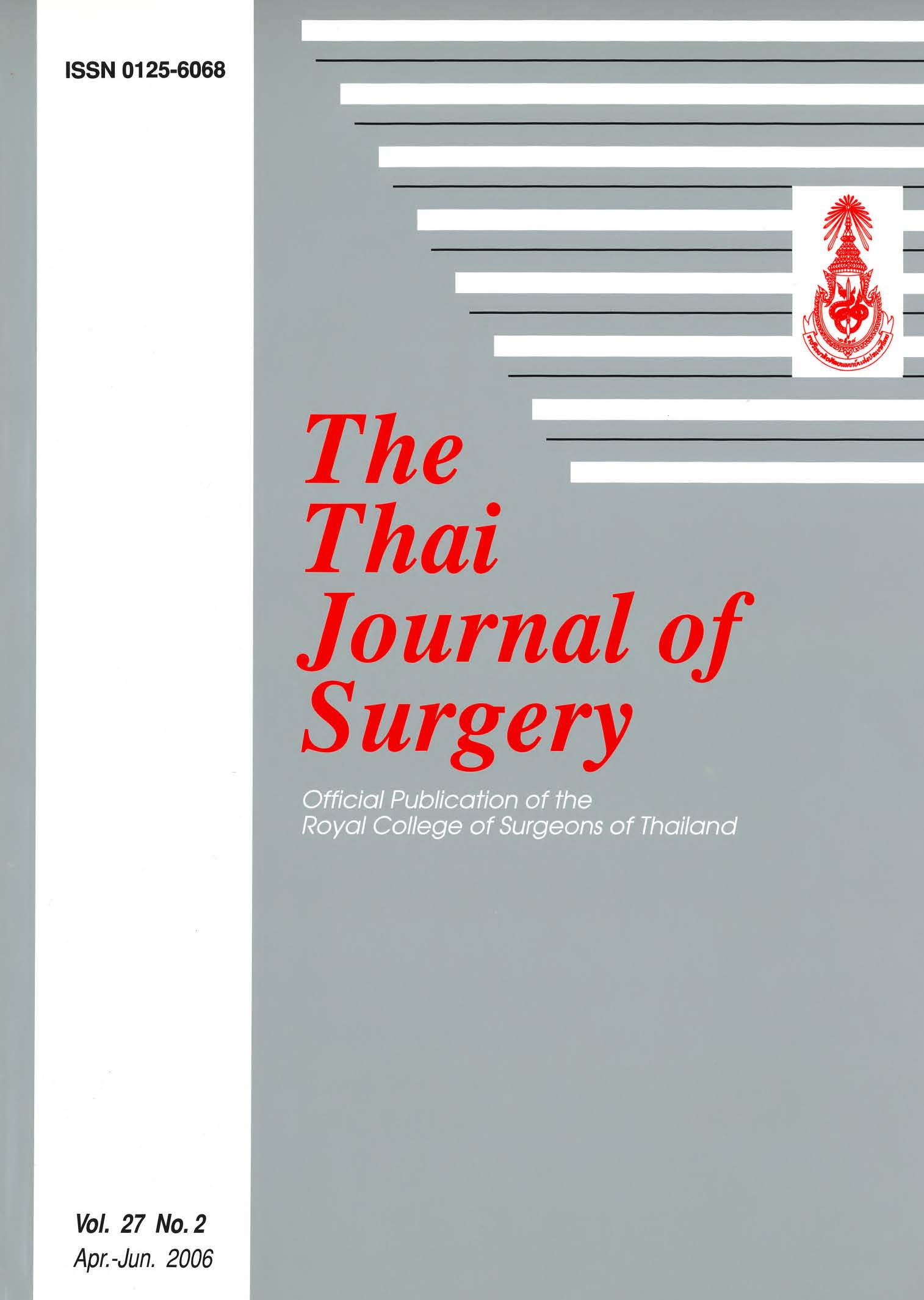Risk Factors Predicting Morbidity and Mortality in Peptic Ulcer Perforation at Maharaj Nakorn Chiangmai Hospital
Abstract
Background: Peptic ulcer perforation (PUP) is one of the important problems in Maharaj Nakorn Chiangmai Hospital due to high morbidity and mortality. If the risk factors of these outcomes are identified, modification of these risk factors may improve the outcomes. This study was conducted to identify these risk factors.
Methods: Data of 203 patients with PUP admitted to Maharaj Nakorn Chiangmai Hospital from January 2001 to October 2004 were studied retrospectively. General health data and data of twelve relevant risk factors were collected. The risk factors were analyzed by chi-squared test.
Results: The overall morbidity rate was 21.2% and mortality rate was 12.8%. Risk factors significantly associated with high mortality were age over 60 years, patient with underlying diseases (hypertension, diabetes mellitus, COPD, renal insufficiency, CHF, IHD, CA lung), duration from abdominal pain to operation more than 12 hours, hypotension before surgery, perforated size larger than 0.5 cm, and severe degree of contamination. The mean hospital stay was 8.64 days and number of patients who stayed more than 8 days was 50 (24.6%). Risk factors significantly associated with increasing hospital stay of more than 8 days were similar to those predicting mortality.
Conclusion: This study showed clearly that the duration before operation and hypotension were associated with high mortality and morbidity. Surgeons should modify these risk factors before surgery or referral.
References
2. Rahuman MM, Saha AK, Rahim A. Experience of peptic ulcer perforation over a decade in a teaching hospital of southern Bangladesh. Ceylon Med J 2003; 48: 53-5.
3. Gisbert JP, Pajares JM. Helicobacter pylori infection and perforated peptic ulcer prevalence of the infection and role of antimicrobial treatment. Helicobacter 2003: 8: 159-67.
4. Rajesh V, Chandra SS, Smile SR. Risk factors predicting operative mortality in perforatedpeptic ulcer disease. Trop Gastroenterol 2003; 24:148-50.
5. Svanes C, Salvesen H, Stangeland L, Svanes K, Soreide O. Perforated peptic ulcer over 56 years. Time trends in patients and disease characteristics. Gut 1993; 34: 1666-71.
6. Wilson DE. Gastroduodenal ulcers: causes, diagnosis, prevention, and treatment. Compr Ther 1990; 16: 43-53.
7. Gunshefski L, Flancbaum L, Brolin RE, Frankel A. Changing patterns in perforated peptic ulcer disease. Am Surg 1990;56:270-4.
8. Andersen IB, Jorgensen T, Bonnevie O, Gronbaek M, Sorensen TI. Smoking and alcohol intake as risk factors for bleeding and perforated peptic ulcers: a population-based cohort study. Epidemiology 2000; 11: 434-9.
9. Svanes C. Trends in perforated peptic ulcer: incidence, etiology, treatment, and prognosis. World J Surg 2000; 24:277-83.
10. Svanes C, Lie RT, Kvale G, Svanes K, Soreide O. Incidence of perforated ulcer in western Norway, 1935-1990: cohort- or period-dependent time trends? Am J Epidemiol 1995;141:836-44.
11. Debongnie JC, Wibin E, Timmermans M, Mairesse J, Dekoninck X. Are perforated gastroduodenal ulcers related to Helicobacter pylori infection? Acta Gastroenterol Belg 1995;58:208-12.
12. Reinbach DH, Cruickshank G, McColl KE. Acute perforated duodenal ulcer is not associated with Helicobacter pylori infection. Gut 1993; 34: 1344-7.
13. Uccheddu A, Floris G, Altana ML, Pisanu A, Cois A, Farci SL. Surgery for perforated peptic ulcer in the elderly. Evaluation of factors influencing prognosis. Hepatogastroenterology 2003;50:1956-8.
14. Testini M, Portincasa P, Piccinni G, Lissidini G, Pellegrini F Greco L. Significant factors associated with fatal outcome in emergency open surgery for perforated peptic ulcer. World J Gastroenterol 2003; 9: 2338-40.
15. Noguiera C, Silva AS, Santos JN, et al. Perforated peptic ulcer. main factors of morbidity and mortality. World J Surg 2003;27: 782-7.
16. Makela JT, Kiviniemi H, Ohtonen P, Laitinen SO. Factors thot predict morbidity and mortality in patients with perforated peptic ulcers. Eur J Surg 2002; 168: 446-51.
17. Sillakivi T, Lang A, Tein A, Peetsalu A. Evaluation of risk factors for mortality in surgically treated perforated peptic ulcer. Hepatogastroenterology 2000; 47:1765-8.
18. Chan WH, Wong WK, Khin LW, Soo KC, Adverse operative risk factors for perforated peptic ulcer. Ann Acad Med Singapore 2000; 29: 164-7.
19. Hermansson M, Stael von Holstein C, Zilling T. Surgical approach and prognostic factors after peptic ulcer perforation. Eur J Surg 1999; 165: 566-72.
20. Mclntosh JH, Berman K, Holliday FM, Byth K, Chapman R, Piper DW. Some factors associated with mortality in perforated peptic ulcer: a case-control study. J Gastroenterol Hepatol 1996;11: 82-7.
21. Svanes C, Lie RT, Svanes K, Lie SA, Soreide O. Adverse effects of delayed treatment for perforated peptic ulcer. Ann Surg 1994;220:168-75.
22. Agrez MV, Senthiselvan S, Henry DA, Mitchell A, Duggan JM. Perforated peptic ulcer in the Hunter region: a review of 174 cases. Aust N Z J Surg 1992; 62: 338-43.
23. Koness RJ, Cutitar M, Burchard KW. Perforated peptic ulcer. Determinants of morbidity and mortality. Am Surg 1990; 56:280-4.
24. Boey J, Wong J, Ong GB. A prospective study of operative risk factors in perforated duodenal ulcers. Ann Surg 1982;195:265-9.
Downloads
Published
How to Cite
Issue
Section
License
Articles must be contributed solely to The Thai Journal of Surgery and when published become the property of the Royal College of Surgeons of Thailand. The Royal College of Surgeons of Thailand reserves copyright on all published materials and such materials may not be reproduced in any form without the written permission.



